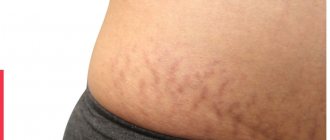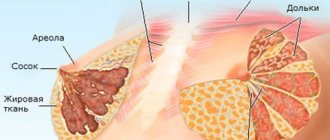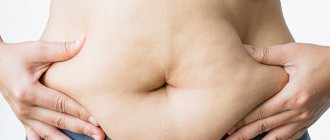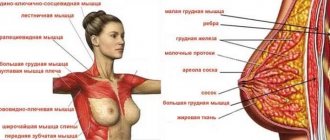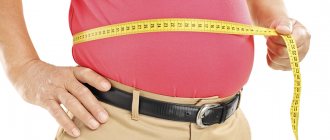Degrees of mastoptosis
Ptosis (mastoptosis) of the mammary glands is sagging of the breasts due to loss of elasticity and firmness, as well as a number of other reasons.
First of all, this is an aesthetic problem, which sometimes becomes psychological, as the woman begins to feel embarrassed about her body. This defect often occurs in girls. There are several degrees of mastoptosis. Normally, the nipple is located 5-7 cm above the inframammary fold located under the breast. Depending on the prolapse of the nipple, there are 3 degrees of ptosis:
- I - the nipple is lowered to the level of the pectoral fold, the sagging is unnoticeable;
- II - the nipple is located below the inframammary fold, ptosis is noticeable;
- III - the nipple is directed downwards, the sagging of the breast from the inframammary fold is more than 5 cm, pronounced.
In addition to the described degrees, pseudoptosis is also distinguished, in which the mammary glands sag, but the nipple is located above the fold. This type is typical for those with large breasts.
The presence of sagging is quite simple to determine: you need to place a pencil under the chest. If the mammary gland is of normal shape, the pencil falls off. If it persists, then we can talk about mastoptosis. To determine the degree of sagging, a measuring tape is needed to measure the distance from the nipple to the breast fold.
Dissatisfaction with the shape of women's breasts often becomes the cause of complexes and sometimes depression. Correction helps increase self-esteem and self-confidence, makes you feel attractive and young.
Features of getting rid of fat under the breasts
If the breasts increase in size due to poor nutrition and rapid weight gain, you may encounter another unpleasant problem - the appearance of fatty folds under the breasts. Despite the fact that the problem at first glance seems quite complicated, it can be easily overcome if you follow certain rules.
To lose weight quickly, follow these recommendations:
- Completely eliminate fast carbohydrates from your diet, which are quickly digested by the body and make you feel hungry again some time after eating. The most problematic are baked goods, pasta made from first-grade wheat flour, any sweets, alcoholic drinks, quick snacks for beer (crackers, chips, nuts), smoked foods, dishes with a high salt content, and sweet carbonated drinks.
- Try to reduce the usual portions of food you eat per day by half.
- Avoid eating after 6 pm.
- Move as much as possible throughout the day. It will be useful to go for walks before bed, run in the morning, and go to the gym at least three times a week. Positive results in getting rid of fat under the breasts are also demonstrated by swimming in the pool.
- Don't forget about cosmetic procedures. Unnecessary subcutaneous fat is well removed by wrapping using various components. It is the wraps that will help make the skin tighten after getting rid of fat.
- If the above recommendations do not bring the desired result, you can go to extreme measures and sign up for a surgical liposuction procedure. The procedure is expensive, but it will rid the body of folds of fat and further prevent the accumulation of sebaceous deposits.
Be sure to read: Exercise therapy and proper nutrition against the problem of obesity
The main causes of ptosis
There are many reasons why the mammary gland prolapses:
- hereditary factor;
- breast-feeding;
- age-related changes;
- fluctuations in body weight;
- changes in hormonal levels;
- macromastia and gigantomastia;
- smoking.
Let's look at each reason in more detail.
Breast-feeding
During pregnancy, the body prepares for childbirth and subsequent feeding of the child. Under the influence of hormones, the glands increase in size; when breastfeeding, they are filled with milk and increase in volume. After lactation, iron decreases, but stretched skin and ligaments can no longer return to their previous shape. The larger the breasts, and the longer the lactation period lasts, the more the mammary glands stretch.
Hereditary factor
The shape of a girl's breasts is largely determined by the elasticity of the skin and ligaments. This feature is determined by genetics, which is confirmed by many years of observation through family ties.
Age-related changes
Loss of elasticity in the skin and ligaments occurs with age. The body's production of collagen and elastin decreases, and the dermal framework becomes loose. The skin loses its elasticity and ability to support the weight of the glands. This primarily applies to large breasts.
Fluctuation in body weight
Breasts may sag if you gain excess weight. This happens because some of the fatty tissue is deposited in the breasts, its weight increases, and the skin stretches. Breasts can also sag after losing weight, when the fat layer decreases and excess skin forms, which causes ptosis.
Changes in hormonal levels
The glands enlarge even with minor hormonal changes, for example, before menstruation, but the breasts do not sag. Everything can change when serious hormonal disruptions occur in the body due to various endocrine diseases, which increase the risk of mastoptosis.
Gigantomastia
Large mammary glands have significant weight. The ligaments cannot constantly support such breasts; they lose elasticity and stretch over time.
Smoking
This habit, harmful to the body, increases the likelihood of mastoptosis, since nicotine inhibits the synthesis of elastin. The skin loses its elasticity and sags.
Causes of large volumes in the chest area
The most common factor for breast growth in men and women is obesity. If your breasts are large, it means there is a lot of fat in them. Another reason that affects bust volume is hormonal changes. It can be caused by illness, taking medications, or using hormonal cosmetics.
Obesity is often caused by taking certain tricyclic antidepressants, calcium antagonists, drugs to lower blood pressure, and treatment of gastrointestinal diseases.
Many cosmetic products are based on estrogen hormones, which contribute to weight gain. Among them are anti-hair loss shampoos and face creams.
The formation of a bust in women is influenced by heredity, more often through the female line. If the mother had large breasts, there is a high probability that her daughter will have large breasts. No connections have been identified between the size of the mammary glands and the sexuality of their owners. A noticeable increase in the bust occurs during pregnancy and lactation.
Fatty breast enlargement in men is called pseudogynecomastia. It occurs against the background of general weight gain and does not pose a health hazard. Another type of pathology is characterized by the growth of glandular tissue rather than adipose tissue. This phenomenon is called gynecomastia and occurs against the background of diseases of the kidneys, liver, and thyroid gland. Connective tissue (Cooper's ligament) rarely enlarges.
Gynecomastia often affects athletes who take drugs for muscle growth and heavy steroids. Abuse of beer affects the size of male mammary glands. The hops contained in the drink supply the female sex hormone estrogen to the body. Due to its excess in the male body, the volume of fat deposits increases.
Prevention of ptosis
The appearance of mastoptosis can be prevented. There are several measures to prevent breast sagging:
- Properly selected underwear is a good preventive measure against breast cancer. .
- Play sports. Well-developed muscles of the back and chest support the mammary glands well, so choose those sports that develop these muscle groups well, for example, gymnastics and swimming.
- Take care of your breast skin using cosmetics that stimulate the synthesis of elastin and collagen.
- Watch your weight. Avoid sudden weight gain and loss.
- Take a contrast shower to stimulate blood supply to the skin.
If breast ptosis does occur, mastopexy will help restore the previous shape.
Proper nutrition for breast fat
It is important not only to exercise, but also to adhere to proper nutrition, then burning fat in the problem area will not take long.
First of all, you need to switch to fractional meals, replacing the standard three meals a day. Portions should be as small as possible (a slight feeling of fullness should occur), and you should eat every three hours. Such an approach to nutrition will speed up metabolic processes in the body; fat burning will be activated throughout the body, including in the chest area.
Be sure to read: NLP method for losing weight: effective techniques for blocking hunger
Don't forget to drink water. During periods of active weight loss, the body should receive at least 2 liters of water. If you engage in active sports, your daily water intake increases by 2-3 glasses. It is water that allows you to remove harmful waste and toxins from the body that have accumulated as a result of excess weight.
Try to avoid fast carbohydrates as much as possible. They are digested very quickly by the body, make you feel hungry some time after eating and include additional snacks in your diet, which often result in an increase in the number on the scale. You should also avoid saturated fats. It would be preferable to replace them with olive oil, nuts, seeds, fish oil, and avocados.
When losing weight in the chest area, you should also include in your diet foods that activate fat burning processes in the body.
Preparing for surgery
The preparatory period for surgical intervention includes consultation with a plastic surgeon, mammologist, examination, examination, and tests.
Surgeon consultation
At the appointment, the plastic surgeon collects anamnesis, clarifies genetic factors, previous diseases, and allergies to medications.
During the examination, the doctor determines the size of the gland, the degree of ptosis, the ratio of adipose and glandular tissue, structural features of the breast, and the presence of stretch marks. Depending on the degree of mastoptosis, an intervention technique is selected and an operation plan is drawn up. The surgeon clarifies whether the patient plans to lose weight and advises doing so before surgery. In addition to the surgeon, you will need to consult a therapist, and additionally, if there are concomitant diseases, other specialists.
Analyzes
Before surgery, you must have the following tests:
- general blood analysis;
- Rh factor and group;
- coagulogram;
- blood biochemistry;
- blood for HIV (f. 50);
- blood for glucose;
- for hepatitis B (HbsAg) and C (HCV), for syphilis (RW);
- general urine analysis.
Examination and diagnosis
The doctor orders a breast examination. Up to 35 years of age, it includes one ultrasound or MRI procedure, and after 35, a mammogram and two ultrasound examinations are required. Patients with chronic diseases and over 40 are prescribed additional tests.
It is mandatory to do a FLG or chest x-ray, an electrocardiogram with a conclusion. A consultation with an oncologist/mammologist and a physician’s report are required.
Methods of performing the operation
Three main mastopexy techniques have been developed. The method of surgical intervention is chosen by the doctor. The method is determined by the degree of ptosis and the individual structure of the mammary gland.
Mastopexy is performed under general anesthesia. Anesthetics can be administered endotracheally or intravenously. The duration of the correction depends on the extent of the operation. If it is performed without endoprosthetics, it lasts from one and a half to three hours.
Periareolar
This type of technique is indicated only for stage I breast ptosis. The incision is made only around the circumference of the areola. During the operation, the glandular tissue is redistributed and the nipple and areola are moved slightly upward. The seam along the edge of the areola is almost invisible.
Vertical technique
It is used for stage II mastoptosis. The incision is made around the areola, then vertically down to the inframammary fold. The gland tissues are redistributed, raised to the upper pole and fixed. The nipple and areola are also tightened. The size of the areola can be reduced to improve the aesthetics of the breast.
Anchor (T-shaped) method
Performed for grade III ptosis. Before the operation, a marking is made along which the incision is made. The location of the nipple is determined.
The technique is considered classic, in which the incision is made in the shape of an anchor: first along the areola, then vertically down, then along the inframammary fold. During the operation, excess skin is also removed, the glandular and adipose tissue is shifted higher to the upper pole, fixed to the pectoral fascia, and the areola and nipple are moved.
Internal seams are made with absorbable threads. External tissues are sutured with polypropylene threads using a cosmetic suture. After 4 weeks they are removed. Drainage tubes are installed to remove serous fluid and blood. The drainage is usually removed the next day, sometimes a little later.
After the operation, compression garments and sometimes a bandage are worn, which relieves the stress on the sutures and supports the breast while healing.
Breast reconstruction using plastic surgery methods
- Mastopexy. Aesthetic surgery to lift the soft tissues of the bust, correct the shape and location of the areolas and nipples. For minor prolapse, periareolar mastopexy is used - the doctor will remove excess glandular tissue and skin, and tighten the soft tissue in the areola area. For grade II ptosis, vertical mastopexy will be required with tissue correction from the nipple to the inframammary fold. If the changes are significant, a T-shaped mastopexy is performed, which allows you to lift even large breasts, if they are sagging, fix them in a spectacular position, and give the areolas a harmonious appearance.
- Augmentation mammoplasty. The popular breast replacement surgery using silicone implants allows you to give the bust the required volume. You can choose the shape of the endoprosthesis (round, teardrop-shaped), its volume, profile (high, medium, low). During the operation, the doctor will install the implant in the selected area: under the pectoral muscle, mammary gland, or a combination. Access is through the armpit, inframammary fold or lower edge of the areola. With any option, any scars will be barely noticeable.
- Lipofilling. An operation to correct the shape of the breast using the patient’s own fat tissue. It can be performed simultaneously with liposuction - the removal of adipose tissue from areas of the body where there is excess fat. The donor material is processed, cleaned, and then in small doses it is injected into the corrected area of the breast. The result is a tightened bust of a harmonious shape.
Individual consultation
Thank you for your application. Our operator will contact you from 8:00 to 22:00 Applications received after 22:00 will be processed the next day.
Rehabilitation period, advice from a plastic surgeon
After the correction, we leave the patient in the hospital for two days, then she is transferred to outpatient treatment with constant monitoring. After 2-4 weeks, the hematomas disappear, after 5-7 days the pain disappears, and after one month physical activity is restored.
For better healing of sutures and restoration of the shape of the mammary glands, I recommend following some rules:
- To reduce pain, you need to take non-steroidal analgesics for the first four days.
- It is necessary to take antibiotics to prevent mastitis and suppuration of the sutures. The seams need to be treated with antiseptic ointment.
- To make the seams invisible, treat them with a special gel.
- You must wear compression garments for at least six weeks. It helps relieve swelling and reduces the likelihood of stitches coming apart. For the first five days you should always be in this underwear, then you can take it off for a while.
- I recommend using a silicone patch along with compression garments.
- You should avoid hot baths and saunas for two months. You can take a warm shower after 5 days, at which time you can remove the compression garments for a short time.
- Avoid injuries and pressure on the glands throughout the recovery period.
- Sleep on your back for the first month of rehabilitation.
- For the first six months, heavy physical activity and physical education are prohibited. Increase the loads gradually.
- To speed up recovery, use physiotherapeutic procedures, for example, magnetic therapy, which improves metabolic processes and lymphatic drainage.
Results will become visible after two to three months, but full recovery will occur within a year.
Postoperative period
Breast surgery is an operation that lasts 1–2 hours and most often takes place under general anesthesia. After it, the patient needs rest for 24 hours, which she spends in the hospital under the supervision of specialists. On the second day after the dressing, she can return home. The doctor will select a safe pain reliever that will eliminate discomfort.
After a week, the stitches are removed. You need to wear compression garments for 1–2 months. For three months, a hot bath, sauna, swimming pool, or any physical activity are contraindicated. After six months, you can return to a full life.
Breast lift without surgery
Various procedures aimed at improving blood microcirculation, preserving and maintaining the elasticity of the skin and ligaments, and strengthening the muscles of the chest and back will help maintain the shape of the breast.
These include massage, which can be manual. Water or vacuum.
Physiotherapy procedures are considered safe and effective methods of tightening, such as:
- myostimulation;
- mesotherapy;
- biorevitalization;
- microcurrent.
Push-ups, palm rest, exercises with dumbbells and a punching bag will help strengthen your muscles.
To support the procedure, you can supplement with nutrients that stimulate blood circulation and elastin synthesis. These can be essential oils from plants such as ylang-ylang, grape seed, fennel, jojoba, hops, sage, geranium, hazel and others. To prevent women's breasts from sagging, cosmetic masks applied to the mammary glands give good results.
How to remove fat from breasts
Women are more prone to breast enlargement than men, but the methods for eliminating the pathology are similar in both sexes. If the volume of the bust has increased, it is necessary to exclude the possibility of hormonal imbalance - visit an endocrinologist and undergo the necessary tests. After treatment, the mammary glands can take on their natural shape.
If your health is good, excess weight may be the cause of breast enlargement.
In this case, you should reduce the calorie intake, increase physical activity, and evaluate the effect of medications and cosmetics taken on the body. It’s not just hormonal medications that can cause weight gain.
In special cases, they resort to surgical removal of fat - liposuction. During the operation, 3–4 mm incisions are made on the rib near the mammary gland, through which excess fat is pumped out using special instruments. Depending on the size of the operated area, plastic surgery is performed under local or general anesthesia.
Ways to reduce chest girth in men
Men are naturally given a wide chest, so even a slight increase in the bust becomes noticeable. If the cause of the pathology is a disease, it can only be eliminated by treating the underlying disease or by surgery.
When breast growth in a man is due to excess weight, intensive training in the gym will help. Exercises with weights and barbells are effective. Regular training helps strengthen all muscle groups and reduce fat, including in the ribs.
Strength exercises for breast reduction lead to a significant loss of energy reserves in the body. To restore balance, a man is recommended to eat a protein diet. Exercising and eating a balanced diet will not give immediate results. The older a man is, the more difficult it is for him to lose weight.
How to lose weight in a woman's chest
If a healthy woman's weight increases by 1 kg, on average her breasts become 20 g heavier. And vice versa - the mammary gland decreases in proportion to the decrease in body weight. Simple calculations show that if you lose 10 kg, your breasts will lose 200 g of weight.
A sharp decrease in the fat layer often leads to another problem - the mammary gland loses its shape, stretches, sag, and breast asymmetry occurs. This is especially noticeable if the body experiences age-related changes. When losing weight, you should take care of the elasticity of the mammary gland and prevent sagging skin.
Regular breast massage gives tangible results. Light stroking, pinching, patting, squeezing increase blood circulation in the mammary gland area and prevent congestion. At home, using a warm shower is easy to perform hydromassage. A contrast shower has a good effect on the shape of the bust - it effectively tones and strengthens blood vessels.
Women use cosmetics and medications more often than men. This creates an additional risk of weight gain. Even vaginal cream can provoke breast growth if it contains hormones. It is necessary, if possible, to exclude those medications that can lead to obesity.
If you have a large bust, you need to choose only high-quality underwear - it supports the breasts and does not allow them to sag under their own weight. You need to wear compression garments while doing fitness or any other sport.



